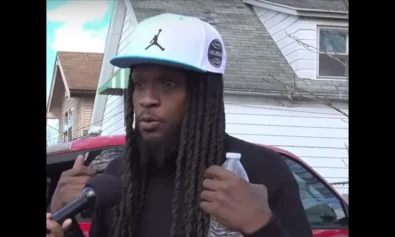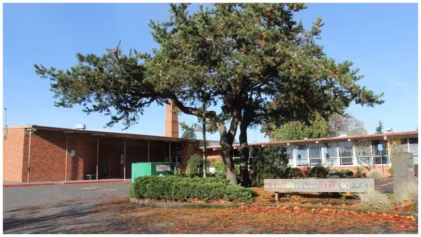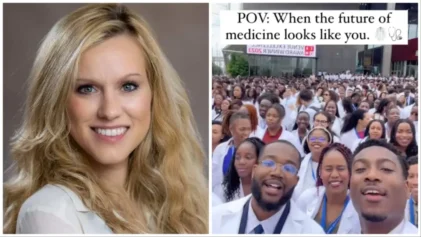Friends and family of a New Jersey man killed by police after he called them for help during a mental health crisis said he was a shooting survivor who worked to reduce gun violence in his neighborhood.
Najee Seabrooks, 31, was shot to death by Paterson police after a four-hour standoff on March 3 at his Mill Street apartment. His friends and coworkers argued if police hadn’t prevented them from negotiating with the man that he still would be alive.
“I’m begging the officer, showing them text messages, things that Najee is saying to me — ‘all I want to do is see your face, and I’m going to come out.’ I told the officers this. They did not allow us in,” Seabrooks’ supervisor, Teddy Martinez, said during a March 7 vigil.

Seabrooks joined the Paterson Healing Collective two years ago after recovering from gunshot wounds in the hospital. He woke up to the executive director Liza Chowdhury and another member standing next to him.
Chowdhury, who had known Seabrooks since he was 16, said it comforted him to see a familiar face after the traumatic experience. She believes his mental health crisis may have been a side effect of the violence he lived through most of his life.
His mother told police during the standoff that facing gun violence every day in Paterson might have taken a toll on him. Seabrooks survived being shot in a drive-by shooting before joining the collective, she said.
“They go around the community and talk to the boys,” body-camera footage shows the mother saying. “I think that’s getting to him, you know.”
In a phone interview with Atlanta Black Star, Chowdhury described Seabrooks as a positive person who always “wanted to be around good vibes.” He was a dedicated father who loved basketball and always tried to be a role model for his younger brother.
Chowdhury, a criminal justice expert and activist, said Seabrooks called her the morning he was killed. He didn’t say much, but she heard the urgency in his voice.
“‘It was I need your help. Come here,’ and he hung up on me,” Chowdhury said.
Chowdhury said she was in South Jersey and could not get to Paterson right away, but eight other members of the collective went to the scene. Seabrooks reportedly had called 911 to ask for help, but after waiting for several minutes, he reached out to his colleagues. The police arrived at the scene first.
“I’m gonna be honest, when he called, I never thought that they were going to kill him,” Chowdhury told Atlanta Black Star. “I just did not expect it. I called other law enforcement people. I called the police director, called the head of community policing, who happens to be a woman of color. They reassured me that this was a team trained to deal with crisis intervention.”
New Jersey Attorney General Matthew J. Platkin’s office released the police footage of the standoff on Thursday, March 16.
It started around right before 8 a.m. that morning. Seabrooks’ mother and other relatives who were in the small apartment said he was paranoid and seemed to be hallucinating and behaving erratically. They asked the officers to call an ambulance. Seabrooks barricaded himself in the bathroom.
Activists outside say they met police at the scene, but they were prevented from intervening in the standoff.
Paterson Police’s Crisis Negotiation Team and the Emergency Response Team along with other officers responded to the call. Seabrooks had multiple knives that he uses to cut himself. Near the end of the deadly standoff, he sets a fire inside the bathroom.
His family said he had been held up in the bathroom with the knives since 2 a.m. One relative told police that he could’ve been having a bad reaction to some marijuana because the behavior was out of character.
“People are trying to kill me. I need an escort,” Seabrooks yells through the bathroom at the first officers who arrived.
The cops tried to coax Seabrooks out of the bathroom, ensuring him that no one is out to get him. He instead makes other 911 calls and contacts police agencies in other cities for help.
Seabrooks’ mother tearfully begs him to come out of the bathroom during the first hour of the standoff.
“Why is you doing this, Najee,” she says.
“Tell me why y’all doing this,” he replies.
“Najee, I’m your mother,” she pleads.
Most of the interaction between the mother and son is then muted in the body-camera video.
As the hours go by, Seabrooks’ family is moved to another floor of the apartment building. Cop after cop tries to talk the man out of the bathroom, but he refuses. Eventually, about 10 officers fill the apartment, some with shields and heavy weaponry.
The Crisis Negotiation Team is a specialized unit that is trained to negotiate with people in crisis.
In the final minutes of the standoff, the officer leading the negotiations tells Seabrooks that he can connect with his mentor, but he needs to get him to the hospital for medical attention first. But he continues to cut himself with the knife in the flooded bathroom.
“Put the knives on the floor, Naj,” the officer says. “Nobody’s going to shoot you.”
“Let us get you the help you need. Stop cutting yourself, ” the officer says. “Stop! Stop! Let us help you.”
However, Seabrooks tells the officer he will kill one of them and “anyone he sees I’m gonna to kill ’em.”
“You don’t want to do that. It’s not worth it, alright,” the officer replies. Seabrooks then continues to cut himself.
Videos of Seabrooks’ last moments are obstructed by body shields as the bloody man makes a quick appearance at the door with a large knife. The officers report that Seabrooks lunged at them with the knife which prompted them to discharge their weapons.
Two members of the response team, officers Anzore Tsay and Jose Hernandez shot Seabrooks at 12:35 p.m. He was pronounced dead 16 minutes later at Saint Joseph’s Medical Center.
“He begged us to see us in our group chat, and we sent a picture to show him our team was downstairs, but they’re just not letting us in,” Chowdhury said.
The Paterson Healing Collective helps gun violence survivors get federally-funded victim services that they are often unaware are available. They connect them with other gun violence victims and OGs, who offer moral support. The organization greets the victims at their bedsides and accompanies them to follow-up visits, physical therapy and other appointments. Chowdhury said it’s a form of restorative justice.
Survivors who get help from the collective are less likely to retaliate or be shot again. Since the collective fully launched last year, the director said gun violence has been down 20 percent. Only three of the 200 gunshot victims the organization has worked with have been reinjured, she said.
Seabooks was a high-risk interventionist with the collective.
“His skill set includes a very strong mindset who is always willing to learn and help others out,” his bio on the organization’s website said. He majored in social and behavioral sciences and witnessed “a lot of traumas,” it also said.
Chowdhury said her team started to rally for answers the same day Seabrooks was killed. Over 250 people marched to the city hall four days after demanding action from officials.
Black Lives Matter Paterson and the Paterson Healing Collective are demanding the officers involved in the shooting be placed on administrative leave and the creation of a non-carceral crisis response team and a civilian complaint review board.
“We believe that officers are not equipped to handle these types of situations. We need to be able to have an autonomous group that’s not police officers, that’s coming in riot gear to handle the situations,” Zellie Thomas, Black Lives Matter Paterson president, told Atlanta Black Star.
“We believe that people are able to handle these types of situations with love, care and understanding and not with weapons and aggression and that’s training to kill someone if they feel threatened.”
The attorney general’s office is required by law to investigate police-involved killings. The office must also present its findings to grand jurors who would decide whether to indict the officers. Its investigation is ongoing.


